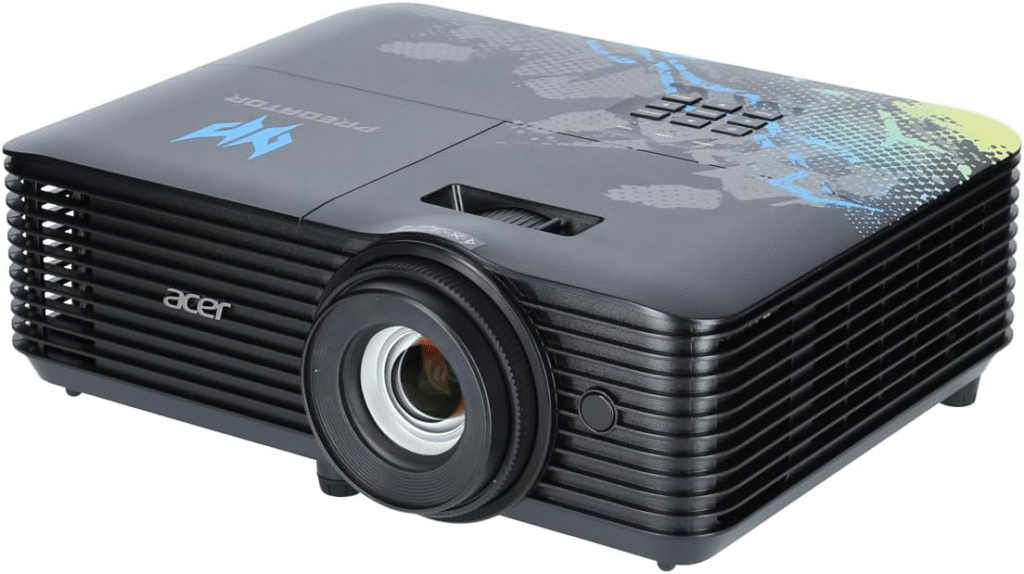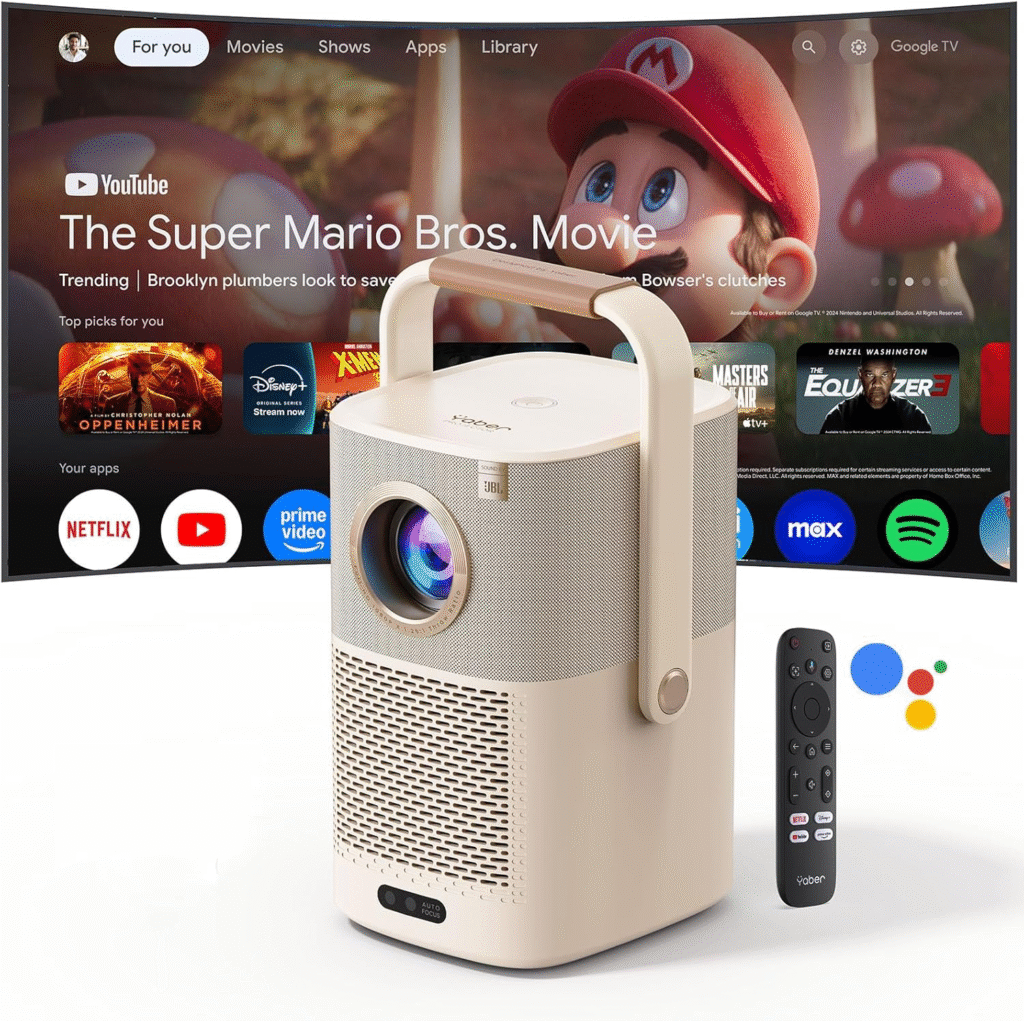Best Low Latency Projector for Gaming in 2025: Play Without Lag
Table of Contents
Ever had a perfect kill shot ruined by a split-second delay? You’re not alone – gamers hate lag. That’s why a low latency projector for gaming is such an exciting idea. Imagine a giant screen that keeps up with your reflexes – not just any old movie projector. In fact, recent gaming projectors promise “dedicated, rich gaming experiences on displays twice bigger than anything TVs manage without sacrificing response”. In plain terms: big-screen immersion and snappy gameplay. Let’s dive in and see why input lag matters, how projectors compare to TVs, and which models can deliver smooth play on a wall-sized canvas.
Why Input Lag Matters in Gaming Projectors
Input lag is the tiny delay between your controller button press and the action appearing on screen. Think of it as the gap between your reflex and the image – even a few milliseconds can throw off fast games. Manufacturers list input lag in milliseconds (ms); for example, 16ms means a 0.016‑second delay between console and display. In gaming, that’s huge: racing turns feel sloppy and opponents can see your moves first. Experts say anything under ~20ms is ideal for competitive play. BenQ even calls 0–20ms “high speed” gaming, 20–40ms “fast,” and warns that over 50ms starts to get “weird”. In practice, under ~20ms is the holy grail, 20–50ms is okay for casual play, and higher lag can spoil the experience. So when you’re shopping for a gaming display – be it a TV, monitor or projector – check that response time. In short, a good response time for a gaming projector is around 20ms or less
Projector vs TV for Gaming Input Lag
Traditionally, TVs have had the edge on lag – especially budget TVs (often 30ms+ without a gaming mode). But today’s gaming projectors are catching up. BenQ notes that “good TVs with dedicated gaming modes have low input lag, but so do new gaming projectors – they’re at parity for the most part. In other words, the old myth of sluggish projectors is fading. In fact, modern BenQ console projectors boast ~8ms lag at 1080p/120Hz and ~16ms at 4K/60Hzbenq.com – numbers in line with many TVs. Even a side-by-side comparison shows projectors now matching TVs in refresh and latency, just at a much larger screen.
So in the projector vs TV for gaming input lag debate, the gap has narrowed. A high-end gaming projector can be very responsive – think single-digit ms on 1080p at high Hz. Meanwhile, the big win for projectors is size: you get a far bigger image for the money (BenQ highlights gaming projectors on screens “twice bigger” than typical TVs, still hitting 120Hz and low lag). The trade-offs? TVs still handle bright rooms better and some high-end monitors offer sub-5ms lag. But for many players, today’s gaming projectors deliver that immersive cinema feel with lag that’s almost as low as a TV.
Best Low Latency Projector for Gaming in 2025
Looking for the top performers? Here are some picks (rough prices in USD, US audience):
- BenQ X3100i – Best Overall. A 4K DLP console projector (short-throw) with a huge 3300 ANSI lumens. It’s rated to 4.2ms at 1080p/240Hz and 16ms at 4K/60Hz, so even competitive play stays smooth. Bright and color-accurate, it’s pricey (~$2400) but well-loved: reviewers call it a flagship with “super low latency” and vibrant picture.

- BenQ X500i – Best 4K LED Gaming Projector. A short-throw 4K HDR model ($1600-ish) that also reaches low lag. It delivers 4ms lag at 1080p/240Hz and supports 4K/60Hz. Its LED light engine keeps it bright (2200 lumens) and quiet, with great color. PCGamesN notes its Game Mode gave “buttery smooth gameplay” with near-zero lag.

- Acer Predator GM712 – Best Budget Projector for Gaming. A 4K DLP projector (~$1500) marketed as a budget champ. It cranks 4000 lumens and supports VRR/FreeSync. Input lag is around 15.2ms, which is excellent for the price. PCGamesN and others call it a solid pick for serious gamers on a budget – not as flashy in features, but it simply plays games well at a huge screen.

- Yaber T2 Plus – Ultra Budget / Portable. A 1080p LED thrower (~$500) more for casual gaming and movies. It has modest 450 ANSI lumens, so it needs dim light. Its lag is higher (since it tops out at 1080p60), making it better for single-player or outdoor movie night vibes. Still, GamesRadar calls it “the best budget gaming projector” for its features and price. If you want something cheap and portable for light gaming, this is a surprise performer – just don’t expect pro-level responsiveness.

- BenQ TK700STi – 4K Short-Throw Value ($1700). An older BenQ model (4K@60Hz short throw) that made headlines as the first 16ms 4K projector. It’s less bright and no Android built-in, but it hits 16ms lag at 4K/60 and 4.16ms at 1080p/240Hz. If you find it on sale, it’s a decent deal for a 4K experience at short distance (great for small rooms or sweet spots).

Each of the above handles fast gaming better than an average projector. Prices vary, but all focus on low lag. For true budget shoppers, models like the Acer GM712 or even older X3000i/X3100i (often discounted) are worth a look. The term “best budget projector for gaming” pops up in many reviews for them.
BenQ Gaming Projector Review
BenQ is a leader in gaming projectors, and reviews reflect that. Their recent X-series consoles (X3000i/X3100i) are favorites. For example, ProjectorReviews notes the X3100i achieves stunning speed – 4.2ms input lag at 1080p/240Hz – thanks to its DLP technology. RTINGS.com similarly praises the X3000i, saying it’s “very capable for gaming with 1080p @ 240Hz support and low input lag”. In BenQ’s own words, the (2021) TK700STi was “world’s first 4K @ 60Hz gaming projector with 16ms lowest input lag ever”. In short, BenQ gaming projector reviews consistently mention buttery-smooth gameplay. They’re clearly tuned for players, with features like specialized game modes and fast DMD chips. If you’re looking at a BenQ console projector, know that lag will likely be minimal – just what hardcore gamers want.
How to Reduce Input Lag on Projector
Even the best projector can be tuned for more speed. Try these tips to reduce input lag on projector:
- Enable Game/Fast Mode: Almost every gaming projector has a Game Mode or Fast Mode. Turning this on bypasses extra image processing, often shaving off several milliseconds.
- Use Direct HDMI (2.1) Connections: Plug your console/PC straight into the projector using a high-quality HDMI cable (ideally HDMI 2.1 for 4K120/144Hz). Avoid splitters or receivers when possible.
- Turn Off Extras: Disable keystone correction, noise reduction, motion smoothing, or other “helpful” features. These add processing time. BenQ advises turning off keystone/overscan and any image enhancements in Fast Modebenq.com.
- Match Resolutions/Refresh Rates: Set your console/PC to the projector’s optimal mode. For example, if it can do 1080p@240Hz, use that for competitive play; otherwise 4K@60Hz is fine. Mismatched signals can introduce.
- Use Wired Controllers: If your controller supports it, plug it in or use a low-latency wireless mode. Sometimes Bluetooth controllers can add a few ms compared to wired or dedicated wireless adapters.
These simple adjustments can trim lag further. Even a couple of ms can be the difference in a tight online match.
Who Should Choose a Low Latency Projector for Gaming?
A low latency projector for gaming is perfect for many players. If you love console gaming on the couch – racing games, sports titles, RPGs, couch co-op or even FPSes with friends – the big immersive screen with almost no lag is awesome. Console players with PS5/Xbox Series X will especially benefit from 120Hz modes on projectors and the huge picture. PC gamers can also enjoy it: drop to 1080p/144Hz or 120Hz for very low lag, and use VRR where available. That said, tournament-level FPS pros might still prefer a 1ms monitor for razor-thin advantage; even 8ms is a bit more than a top monitor’s 1–4ms. But for everyone else – casual FPS, action-adventures, strategy or just movie-style gaming – a low latency projector keeps gameplay smooth while delivering a giant display. In other words, ask yourself: Do I want wall-sized gaming with only a few milliseconds of lag? If yes, this setup is for you.
Conclusion
Gaming on a projector doesn’t have to mean slow response. A modern low latency projector for gaming gives you the best of both worlds: a cinematic, wall-filling view and twitchy controls. Thanks to new tech, many projectors now match TVs in lag while offering much bigger screens. So if you’ve ever dreamed of racing on a 100-inch track or watching cutscenes on a theater-size wall without feeling sluggish, give a gaming projector a try. You might be surprised how buttery smooth it can be. In short, a low latency projector won’t ruin your reflexes – it just makes everything bigger and more exciting. Test one out and see your favorite games like you’ve never seen them before!